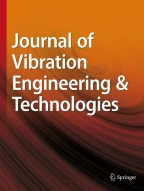Abstract
Purpose
Hardened steels are being extensively used in aerospace, automobile industries, bearing and die industries. High hardness of such steels makes it difficult to machine. During turning process of such materials, the cutting tool is subjected to heavy mechanical load and thus creates vibrations throughout machining process. It affects the surface quality of machined part and provokes higher rate of tool wear with lowering tool life. Therefore, measurement and prediction of vibration induced is of prime importance.
Objective
The aim of this paper is to evaluate vibration acceleration and surface roughness with varying machining parameters such as cutting speed, feed and depth of cut to develop predictive mathematical model.
Methods
The central composite rotatable design (CCRD) method is used in designing the experimental runs. The experimental results are further used to develop mathematical models using regression analysis. It is performed using Design Expert tool. The ANN model is developed using MATLAB tool and the predictions are obtained with acceptable deviations. The comparison of predictive model with experimentation is performed to report the deviation.
Results
The examination of the outcomes revealed that the cutting conditions are having prominent and mixed-type effect on vibration signals. The regression and ANN models have been found to be acceptable for prediction of vibration induced and the surface roughness. The coefficient of regression (\(R^{2}\)) is found to 0.92 which shows that the developed mathematical models have a good approximation in correlating the effect of cutting parameters on vibration of a cutting tool. The obtained correlations are verified by conformity test and have reported the close degree of agreement with respect to experimental values. It registered a lowest deviation of 3.3%. The ANN model is effective in reproducing experimental results through simplifying the complex machining process. The investigation reports predictions of ANN are more accurate than regression analysis. The surface roughness predictions agreed well with experimental results and registered the acceptable deviation of 4.33% using regression analysis and 1.37% using ANN approach.
Similar content being viewed by others
References
Chinchanikar S, Choudhury SK (2015) Machining of hardened steel—experimental investigations, performance modeling and cooling techniques: a review. Int J Mach Tools Manuf 89:95–109
Teti R, Jemielniak K, O’Donnell G, Dornfeld D (2010) Advanced monitoring of machining operations. CIRP Ann Manuf Technol 79:717–739
Gonzalez-Laguna A, Barreiro J, Fernandez-Abia A, Alegre E, Gonzalez- Castro V (2015) Design of a TCM system based on vibration signal for metal turning processes. Procedia Eng 132:405–412
Martini A, Troncossi M (2016) Upgrade of an automated line for plastic cap manufacture based on experimental vibration analysis. Case Stud Mech Syst Signal Process 3:28–33
Prasad BS, Babu MP (2017) Correlation between vibration amplitude and tool wear in turning: numerical and experimental analysis. Eng Sci Technol Int J 20:197–211
Upadhyay V, Jain PK, Mehta NK (2013) In-process prediction of surface roughness in turning of Ti–6Al–4V alloy using cutting parameters and vibration signals. Measurement 46:154–160
Hessainia Z, Belbah A, Yallese MA, Mabrouki T, Rigal JF (2013) On the prediction of surface roughness in the hard turning based on cutting parameters and tool vibrations. Measurement 46:1671–1681
Bhuiyan MSH, Choudhury IA (2015) Investigation of tool wear and surface finish by analyzing vibration signals in turning Assab-705 steel. Mach Sci Technol 19(2):236–261
D’Mello G, Srinivasa PP, Puneet NP, Ning F (2016) Surface roughness evaluation using cutting vibrations in high speed turning of Ti–6Al–4V—an experimental approach. Int J Mach Mach Mater 18(3):288–312
Ghorbani S, Kopilov VV, Polushin NI, Rogov VA (2018) Experimental and analytical research on relationship between tool life and vibration in cutting process. Arch Civil Mech Eng 18:844–862
Kataoka R, Shamoto E (2019) Influence of vibration in cutting on tool flank wear: fundamental study by conducting a cutting experiment with forced vibration in the depth-of-cut direction. Precision Eng 55:322–329
Suyama DI, Diniz AE, Pederiva R (2017) Tool vibration in internal turning of hardened steel using cBN tool. Int J Adv Manuf Technol 88:2485–2495
Montgomery DC (2014) Design and analysis of experiments, 6th edn. Wiley, Hoboken
Chen Y, Jin Y, Jiri G (2018) Predicting tool wear with multi-sensor data using deep belief networks. Int J Adv Manuf Technol 99:1917–1926
Sabzi S, Abbaspour-Gilandeh Y (2018) Using video processing to classify potato plant and three types of weed using hybrid of artificial neural network and particle swarm algorithm. Measurement 126:22–36
Korkut I, Acir A, Boy M (2011) Application of regression and artificial neural network analysis in modelling of tool–chip interface temperature in machining. Expert Syst Appl 38:11651–11656
Bouzid L, Yallese MA, Chaoui K, Mabrouki T, Boulanouar L (2015) Mathematical modeling for turning on AISI 420 stainless steel using surface response methodology. J Eng Manuf 229(1):45–61
Acknowledgements
The authors are grateful to University Research Cell, SP Pune University, India for providing research fund, Sanction no. OSD/BCUD/303/2016 and the Department of Mechanical Engineering, VIIT, Pune, India, for allowing laboratory facility to carry out the research work.
Author information
Authors and Affiliations
Corresponding author
Additional information
Publisher's Note
Springer Nature remains neutral with regard to jurisdictional claims in published maps and institutional affiliations.
Rights and permissions
About this article
Cite this article
Ambhore, N., Kamble, D. & Chinchanikar, S. Evaluation of Cutting Tool Vibration and Surface Roughness in Hard Turning of AISI 52100 Steel: An Experimental and ANN Approach. J. Vib. Eng. Technol. 8, 455–462 (2020). https://doi.org/10.1007/s42417-019-00136-x
Received:
Revised:
Accepted:
Published:
Issue Date:
DOI: https://doi.org/10.1007/s42417-019-00136-x
